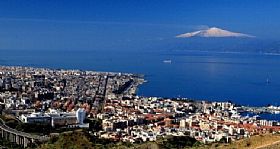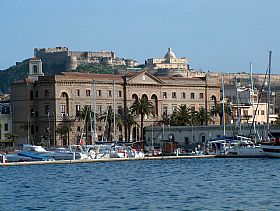Reggio Calabria

Calabria's most populous city and historic center of Greek culture, Reggio Calabria is a bustling port and busy city. It is best known as the "jumping off point" for Sicily, where the ferries depart for the fabled island, but there is more to Reggio Calabria than just its transportation connections. It was a culturally-important and strategic city even during the Greek period, when it was named Rhegio.
It is the most densely populated in the region, located right at the point where the Tirrenian Sea meets the Ionian Sea on the Straight of Messina, looking at the island of Sicily. This gives ample beaches on both sides of the peninsula's toe. But more than a seaside town, Reggio is better known for its cultural sights.
First up is the famed Museo Nazionale di Reggio Calabria, hailed one of southern Italy's best museums. It houses an epic collection of Greek artifacts, so many in fact that it is often referred to as the Magna Grecia Museum rather than its state-bestowed national name. Inside are many wonders, best known among them are the Bronzes of Riace, two incredible bronze Greek sculptures found immersed in the water by a snorkeler in 1972. They were restored and put on display in a carefully climate-controlled room to preserve the ancient masterpieces. There is also the world's oldest known Greek bust, The Philosopher. The museum is worth just these attractions, but there is so much more, including an array of artifacts found at Locri, along with countless Roman finds, as well.
Then there is the city's cathedral. First built in Gothic style following the Norman invasion, its construction was a symbol that the city was passing from Byzantine to a new order. It was sacked and burned by the Saracens, rebuilt, then redone in 1741 in the trendy Baroque style. An earthquake caused great damage and so it was rebuilt again, this time in the Neo-Romanesque design it currently bears, giving it a unique and distinctive facade. It is the largest church in Calabria, and has beautiful stained glass windows that dazzle the neoclassical interior. A 28-meter high bell tower is a landmark in Reggio. The church was able to retain its many artworks and mosaics from the previous centuries, and there is also a nice Diocesan Museum attached.
The Pinacoteca, or Civic Art Gallery, is also a highlight of Reggio Calabria. Located next to the theater on Corso Garibaldi, it showcases many talented Calabrian and national artists. The symbol of the city is the Castello Aragonese, overlooking the city from its hill. It has seen many centuries of history pass by, including political changes in rulers and regimes and was taken over by Garibaldi in his campaign to take the south and unite it to northern Italy. The castle is used for special exhibits and events and is dramatically flood-lit at night to keep its presence foremost over the city.
Take a walk along the panoramic promenade that skirts the waterfront, and you might just get a glimpse of the famous "fata morgana," a shimmering mirage that occurs here hovering above the water. The seafront also has remains of the Roman baths and Greek walls.
Reggio Calabria hosts a big party called the Festa dello Stetto (Festival of the Straight) every August, highlighting southern traditional music and dance.

 Amalfi Coast
Amalfi Coast Sorrento Coast
Sorrento Coast Tuscany
Tuscany Cilento National Park
Cilento National Park Lake Como
Lake Como Rome and Latium
Rome and Latium Umbria
Umbria Capri and Ischia
Capri and Ischia Venice
Venice Puglia (Apulia)
Puglia (Apulia) Liguria
Liguria Sicily
Sicily Lake Maggiore
Lake Maggiore Lombardy
Lombardy Sardinia
Sardinia Lake Garda
Lake Garda Abruzzo and Marche
Abruzzo and Marche Calabria
Calabria

